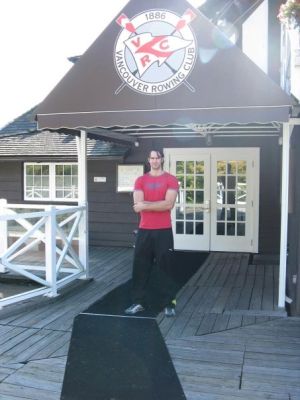
Characteristics of the Sport
Rowing events are held over 2000 metres and typically take 5.5 to 7 minutes depending on the class. Classes are distinguished by the number of members in the boat (single, double/pair, four/quad, eight), whether there is a coxswain steering, and whether the boat is sculled (two oars per person) or rowed (one oar each). Rowing involves lightweight and heavyweight competition. In the lightweight division, male athletes are not permitted to exceed 72.5kg with a crew average of 70kg. For lightweight females, the maximum individual weight is 59kg with a crew average of 57kg. Rowing places great demands on both the aerobic and anaerobic energy systems and requires great power and strength. Nutrition plays a key role in both training and competition phases.
Training
Rowing requires a unique mix of technique, power and endurance of both the aerobic and anaerobic energy systems. This requires long hours of intense training even though events only last 5-7 minutes. Elite rowers train upwards of 11 months of the year with the training stimulus varying markedly depending on the phase of season. A typical rowing session covers upwards of 20 km with 1-2 sessions being held on the water each day, depending on conditions. In addition, rowers undertake gym sessions 3-4 times per week to develop strength and muscular endurance. Additional aerobic cross-training is also regularly scheduled. Road cycling is particularly common, as are rowing ergometer sessions, especially when weather conditions are not inviting on-water. Altogether, rowers often undertake two or more sessions a day, hence ensuring optimal fuelling & recovery are a high priority throughout a training week.
Physical Characteristics
The technical requirements of rowing favor athletes who are tall with long levers, while the force generating requirements encourage very muscular athletes with low body fat levels. Because of this, elite heavyweight rowers tend to be much taller than both the general population and sub-elite rowers. While elite lightweight rowers may be similar in height to the general public, they are more muscular and carry very low body fat levels to assist in achieving body mass limits. Heavyweight rowers are typically ~ 10 cm taller & 15-20 kg heavier than their lightweight counterparts.
Training Nutrition
Heavyweight rowers have high energy and carbohydrate requirements to support training loads and meet body mass and strength goals. All rowers need to work hard to recover between training sessions. A high-energy, high-carbohydrate, nutrient-dense diet is essential throughout the season. Some rowers (particularly male heavyweights) struggle with the sheer volume of food they need to consume, especially when training, work and study commitments can encroach into typical snack times. The use of compact, energy-dense foods (cereal bars, flavoured yoghurt, fruit loaf & bread with thick spreads of peanut paste, jam or honey) or drinks (sports drinks, juice, flavoured milk, liquid meals) are often necessary between meals to keep the volume of food manageable and are also valuable as pre-training snacks prior to early morning training sessions. Rowers need to pay particular attention to recovery after training and organise themselves to have high-carbohydrate snacks on hand immediately after training sessions are completed.
